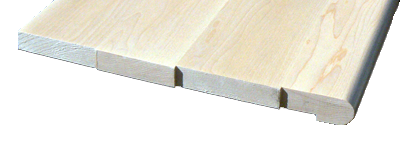Why We Don't Flush Cut Tread Ends

You will notice that Stair-Treads.com does not re-cut our tread ends to exact ordered length after manufacturing. There are quite a few reasons for this:
First and foremost, every stair installer will be re-cutting the ends during the installation process. Staircases are seldom framed perfectly square, much less at a perfect tread size (ie. 42", 48", etc). Not only will an installer need to dimension the tread length to fit the true size of the staircase, they will also need to scribe the exact angle of each individual riser to match the stair case. These normally run at least 1-2 degrees off a typical 90 degree cut.
Second, we guarantee all treads to match nominal dimension given, and with the added over length, you will more often than not receive an additional ¼" to ½" of extra product. We do not guarantee the additional over length.
Finally, and most importantly, during our manufacturing process we treat the ends of all treads with a moisture barrier sealant. This step in the process is applied immediately after the raw material is cross cut before it is ripped, glued and dimensioned to a finished tread. Changes in relative humidity can and will cause wood to either shrink or contract. Most moisture escapes and absorbs through the end grain of wood. When a stair tread looses or gains moisture through the end grain, it has a tendency to either cup, bow, or warp depending on the conditions. By sealing the ends, the tread is less apt to have these problems in non controlled climates such as job sites or warehouses. This allows the tread to be more impervious to changes in its environment until it is ready to be permanently secured on a finished staircase.
The mismatched ends do not look as neat and square when removed from the box; however, there is a reason Stair-Treads.com doesn’t end cut our treads. Ultimately we strive to provide our customers with a better, more stable, and superior product.










Log In